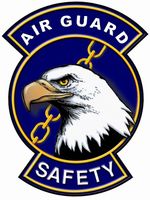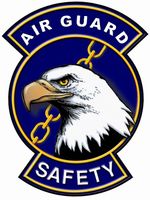Title Page
-
Conducted on
-
Prepared by
-
Location
Spot Inspections
Unit Safety Representatives (USR) should be conducting monthly spot inspections and documenting them IAW 91-202. Utilize the Monthly Spot Inspection Checklist to document and maintain records for one year. Findings/descrepancies require follow-up actions every 30 days until closed. Open findings also need to be forwarded to the Wing Safety Office after 30 days.
-
Are USRs conducting monthly spot inspections?
-
Are USRs properly documenting spot inspections?
Job Safety Training
Each shop/section/unit should maintain a Job Safety Training Outline (JSTO) or Job Safety Training Guide (JSTG) tailored to their individual shop/section/unit. See the Wing Safety SharePoint site for a template: https://intelshare.intelink.gov/sites/angsafety2/101ARW/SitePages/Home.aspx_
-
Is the JSTO/JSTG in place and tailored to the shop/section/unit?
-
Has a supervisor reviewed the JSTO/JSTG and documented the review annually?
-
Is the JSTO/JSTG maintained in a central location that is readily accessible to both supervisors and individuals?
-
Have supervisors attend Supervisor Safety Training (SST) conducted by the Wing Safety Training (E-4 and above and civilians when assigned to a supervisory position).
Unit Safety Representative (USR) Program
Each unit will have a primary and an alternate USR, Additional Duty Weapons Safety Representative (ADWSR), and/or Squadron Assigned Flight Safety Officer (SAFSO) as applicable. A USR is a liaison between the Unit Commander and the Wing Safety Office. See AFI 91-202 for information regarding USR duties and responsibilities.
-
Has the USR completed all required training within 2 UTAs of appointment (USR CBT, RM Training).
-
Is the USR appointment letter current?
-
Has the USR conducted and documented quarterly unit safety briefings to the Unit Commander?
-
Has the USR competed the USR Responsibilities Communicator in MICT?
-
Has the shop level supervisor completed the Supervisor Responsibilities Communicator in MICT?
-
Does the USR ensure all mishaps are reported to the Wing Safety Office within 5 duty days and assist unit personnel and supervisors with mishap reporting?
-
Does the USR maintain a safety bulletin board? Is the information current and relevant?
Respiratory Protection Program
Refer to Bioenvironmental (404-7203) for questions regarding Respiratory Protection Program requirements.
-
Are respirators (half- or full-face) required to accomplish assigned work?
-
Are only authorized respirators being utilized?
-
Have all personnel who are required to wear a respirator completed an annual fit test?
-
Is training provided and documented?
Ladder Safety
Personnel who use ladders (portable and fixed) at any working height shall be adequately trained in the care and use of different types of ladders. See AFI 91-203 chapter 7 for more information.
-
Are personnel required to use ladders (portable or fixed) at any working height?
-
Has a ladder safety lesson plan been developed for the specific ladders that personnel use?
-
Is the ladder safety lesson plan periodically reviewed?
-
Is ladder safety training documented IAW AFI 91-202?
Fall Protection Program
Fall Protection is required for workers working in elevated locations on open-sided floors and platforms and near floor and wall openings. Fall protection shall be provided when workers can fall: 4 feet for more for General Industry (29 CFR 1910); or six feet or more for Construction (29 CFR 1926). See AFI 91-203 chapter 13 for more information.
-
Do workers work in elevated locations on open-sided floors and platforms and near floor and wall openings? Is there a potential for the worker to fall 4 feet or more (General Industry) or 6 feet or more (Construction)?
-
Has a unit/section/shop specific Fall Protection lesson plan been developed?
-
Is the Fall Protection lesson plan periodically reviewed and updated as required?
-
Has a supervisor been designated in writing, and is that person responsible for the procurement of required fall protection/fall arrest systems?
-
Does the supervisor ensure that each worker/qualified person/competent person using a fall protection/fall arrest system is trained and evaluated on proper use, application, and inspection of fall protection/fall arrest systems?
-
Is recurring training completed annually, when work conditions change or when new fall arrest systems are used? Is training documented IAW AFI 91-202?
-
Has a rescue plan been developed for fall protection activities? PFAS shall not be allowed if a means to rescue a fallen worker is not available.
Power Tools & Equipment
This section encompasses the use of power tools/powered equipment that is not covered during formal AFSC training (generator, snow blower, lawn mower, etc.).
-
Has a lesson plan been developed for training personnel on the use of power tools/powered equipment?
-
Are personnel trained on the use of power tools/powered equipment, and is the training documented?
-
Do supervisors immediately remove defective tools/equipment from service?
Traffic Safety
-
Have all unit/section/shop personnel who ride motorcycles been accounted for?
-
Have all unit/section/shop motorcycle riders been entered in the Motorcycle Unit Safety Tracking Tool (MUSTT) Database?
-
Has the unit Commander appointed a Unit Motorcycle Representative, and is the appointment letter current?
-
Does the unit commander ensure that initial motorcycle safety briefings are conducted?
-
Does the unit commander ensure that annual preseason motorcycle safety briefings are conducted?
-
Does the unit/section/shop Vehicle Control Officer (VCO) maintain a list of all qualified and trained forklift operators?
-
Does the unit/section/shop VCO maintain a list of all special purpose vehicles, low-speed vehicles, and other government motor vehicles; a lesson plan for each vehicle type; a list of all qualified operators for each vehicle type; and is training documented IAW AFI 91-202?
-
Have all flight line drivers received annual training and has their AF Form 483 been signed off on an annual basis?
Hazardous Energy Control Program (Lock Out/Tag Out - LOTO)
Awareness level training is accomplished via the JSTO/JSTG. This program is required for personnel who are required to control hazardous energy and authorized to perform LOTO procedures.
-
Are workers required to control hazardous energy and are they authorized to perform LOTO procedures?
-
Does the supervisor maintain a list of all equipment/machinery that requires LOTO procedures?
-
Does the supervisor maintain a list of all authorized workers?
-
Does the supervisor maintain sufficient LOTO supplies (tags, logs, etc.)?
-
Have procedures been developed to perform LOTO for each individual machine/piece of equipment?
-
Have all authorized personnel been trained on the Hazardous Energy Control Program and have they been trained on performing LOTO procedures?
Confined Space Program
Awareness level training is accomplished via the JSTO/JSTG. This program is required for personnel who are required to enter and work in confined spaces. See AFI 91-203 for more information. A confined space is one that meets all of the following conditions: - Is large enough to so configured that a worker can bodily enter and perform assigned work. - Has limited or restricted means for entry or exit. - Is not designed for continuous worker occupancy. A Permit-Required Confined Space is one that has one or more of the following characteristics: - Contains or has the potential to contain, a hazardous atmosphere - Contains a material with the potential to engulf someone who enters the space - Has an internal configuration that might cause an entrant to be trapped or asphyxiated by inwardly converging walls or by a floor that slopes downward and tapers to a smaller cross section; and/or - Contains any other recognized serious safety or health hazards.
-
Are personnel required to enter confined spaces to perform work?
-
Does the unit/section/shop maintain a list or map of the location of all permit required and non-permit required confined spaces?
-
Does the commander and/or functional manager ensure personnel who enter confined spaces are properly trained, equipped, and qualified?
-
Is confined space training documented on an AF IMT 55, Employee Safety and Health Record, or equivalent?
-
Does the commander and/or functional manager ensure required equipment is available and properly maintained?
-
Are entry permits (AF Form 1024), including those that are canceled or revoked, retained on file for one year?
-
Does a representative from the unit/section/shop attend Confined Space Program Team meetings?
-
Are MEPs reviewed and approved by the appropriate agencies annually (SE, BE, FD)?
Misc.
-
Has the unit commander completed the New Commander Safety Orientation provided by the Wing Safety staff?
-
Are risk management principles incorporated into unit activities (mission oriented, off-duty, sports & rec, non-standard, etc.)? Is the risk management process documented?
-
Have all personnel completed AF Risk Management Fundamentals Training IAW AFI 90-802?
-
Do unit POCs complete applicable safety-related SACs in MICT? Are they reviewed periodically?
Summary
-
The Safety Assessment is complete.
-
3-Year Mishap Trend: Total number of mishaps: Mishap classes: Leading activity:
-
The Safety/Mishap Prevention Program conformance/performance under the Air Force Safety Management System is:
-
Best Practices:
Weapons Safety Program
Units that store, handle, and/or transport Ammunition and Explosives (AE) will implement the applicable elements of AFMAN 91-201.
-
Does the unit store, handle, or transport munitions/AE?
-
Has the commander appointed a primary and alternate Additional Duty Weapons Safety Representative (ADWSR) and have completed the required training?
-
Have written instructions been developed and approved by the commander and coordinated with Wing Safety?
-
Have all workers that handle, store, or transport AE received training initially and every 15 months thereafter?
-
If the area stores AE, has an AF 2047, Explosive License, been approved and posted in the area?
-
Has the AF 20147, Explosive License been reviewed annually?










